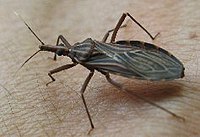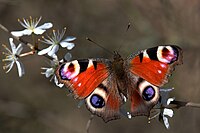
Non-canonical Eclosion Hormone-Expressing Cells Regulate Drosophila Ecdysis
Sign Up to like & getrecommendations! Published in 2020 at "iScience"
DOI: 10.1016/j.isci.2020.101108
Abstract: Summary Eclosion hormone (EH) was originally identified as a brain-derived hormone capable of inducing the behavioral sequences required for molting across insect species. However, its role in this process (called ecdysis) has since been confounded… read more here.
Keywords: ecdysis; hormone; expressing cells; eclosion hormone ... See more keywords

Antimicrobial activity and mechanism of action of a novel peptide present in the ecdysis process of centipede Scolopendra subspinipes subspinipes
Sign Up to like & getrecommendations! Published in 2019 at "Scientific Reports"
DOI: 10.1038/s41598-019-50061-y
Abstract: One of the most important cellular events in arthropods is the moulting of the cuticle (ecdysis). This process allows them to grow until they reach sexual maturity. Nevertheless, during this stage, the animals are highly… read more here.
Keywords: ecdysis; ecdysis process; scolopendra subspinipes; centipede scolopendra ... See more keywords

The ecdysis triggering hormone system is essential for successful moulting of a major hemimetabolous pest insect, Schistocerca gregaria
Sign Up to like & getrecommendations! Published in 2017 at "Scientific Reports"
DOI: 10.1038/srep46502
Abstract: Insects are enclosed in a rigid exoskeleton, providing protection from desiccation and mechanical injury. To allow growth, this armour needs to be replaced regularly in a process called moulting. Moulting entails the production of a… read more here.
Keywords: ecdysis; ecdysis triggering; triggering hormone; hemimetabolous pest ... See more keywords

Application of synchrotron radiation phase-contrast microtomography with iodine staining to Rhodnius prolixus head during ecdysis period
Sign Up to like & getrecommendations! Published in 2018 at "Journal of Instrumentation"
DOI: 10.1088/1748-0221/13/05/c05007
Abstract: Synchrotron radiation phase-contrast microtomography (SR-PHC-CT) has become an important tool in studies of insects, mainly Rhodinius prolixus, the insect vector of Chagas disease. A previous work has shown that SR-PHC-CT is an excellent technique in… read more here.
Keywords: ecdysis; prolixus head; radiation phase; synchrotron radiation ... See more keywords

RNAi of the N-glycosylation-related genes confirms their importance in insect development and α-1,6-fucosyltransferase plays a role in the ecdysis event for the hemimetabolous pest insect Nilaparvata lugens.
Sign Up to like & getrecommendations! Published in 2021 at "Insect science"
DOI: 10.1111/1744-7917.12920
Abstract: Recently N-glycosylation was found to be required for the postembryonic development and metamorphosis of the holometabolous beetle Tribolium castaneum. However, the role of N-glycosylation in the development of hemimetabolous insects is unknown. To further elucidate… read more here.
Keywords: ecdysis; insect; glycosylation related; glycosylation ... See more keywords

Ecdysis triggering hormone is essential for larva–pupa–adult transformation in Leptinotarsa decemlineata
Sign Up to like & getrecommendations! Published in 2020 at "Insect Molecular Biology"
DOI: 10.1111/imb.12691
Abstract: In Drosophila melanogaster, ecdysis triggering hormone (ETH) is the key factor triggering ecdysis behaviour and promoting trachea clearance. However, whether ETH plays the dual roles in non‐dipteran insects is unknown. In this survey, we found… read more here.
Keywords: ecdysis; ecdysis triggering; pupa adult; triggering hormone ... See more keywords

Actin as a cytoskeletal basis for cell architecture and a protein essential for ecdysis in Prorocentrum minimum (Dinophyceae, Prorocentrales)
Sign Up to like & getrecommendations! Published in 2018 at "Phycological Research"
DOI: 10.1111/pre.12214
Abstract: The specific cell architecture of prorocentroid dinoflagellates is reflected in the internal cell structure, particularly, in cytoskeleton organization. Cytoskeleton arrangement in a Prorocentrum minimum cell was investigated using fluorescent labeling approaches, electron‐microscopy and immunocytochemical methods.… read more here.
Keywords: ecdysis; actin; basis; cell architecture ... See more keywords

Prophenoloxidase-Mediated Ex Vivo Immunity to Delay Fungal Infection after Insect Ecdysis
Sign Up to like & getrecommendations! Published in 2017 at "Frontiers in Immunology"
DOI: 10.3389/fimmu.2017.01445
Abstract: Skin immunity protects animals from airborne pathogen infection. Unlike mammals, arthropods, including insects, undergo periodic ecdysis to grow and develop. Newly molted insects emerge with unsclerotized thin cuticles but successfully escape pathogenic infections during the… read more here.
Keywords: ecdysis; insects; fungal infection; infection ... See more keywords